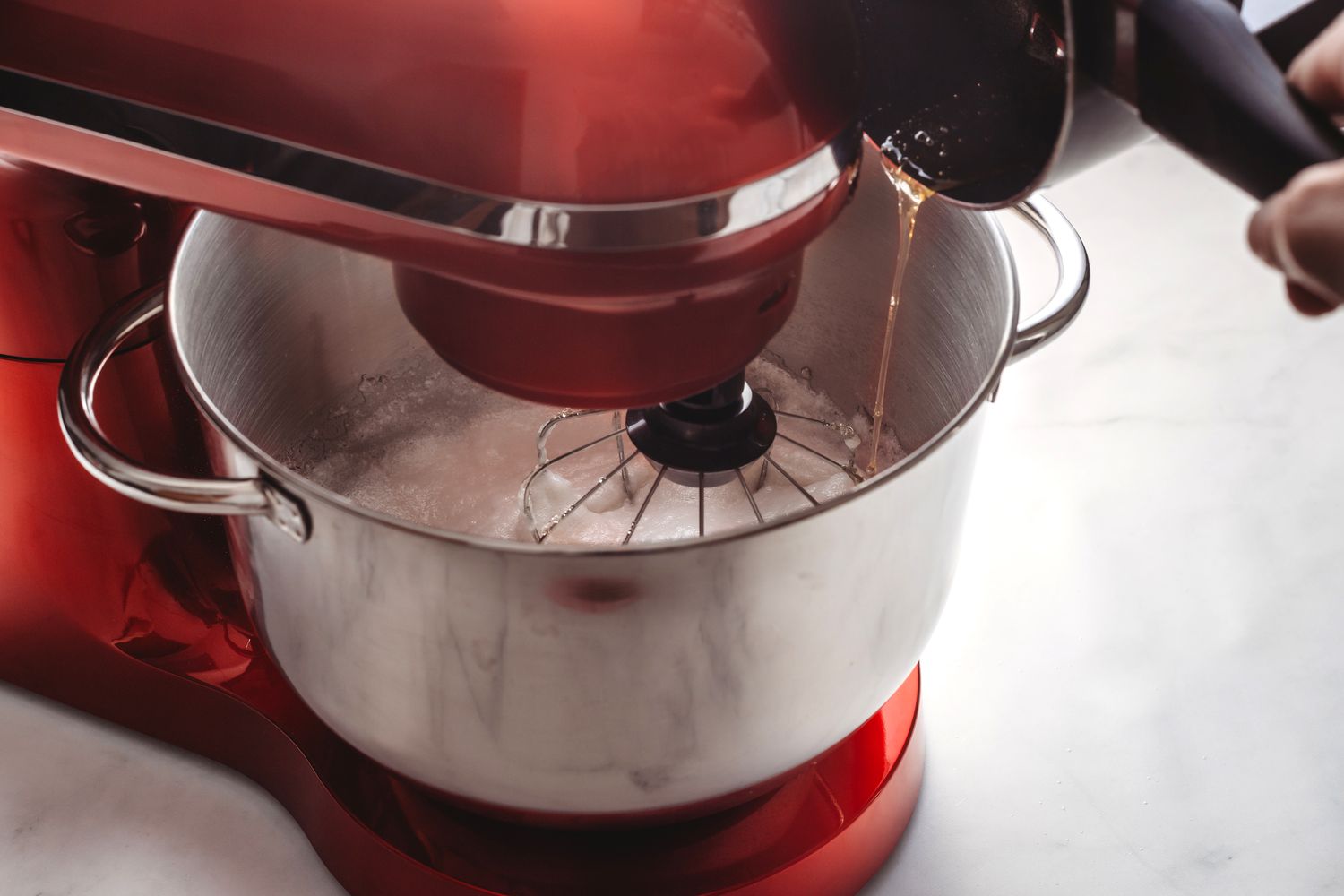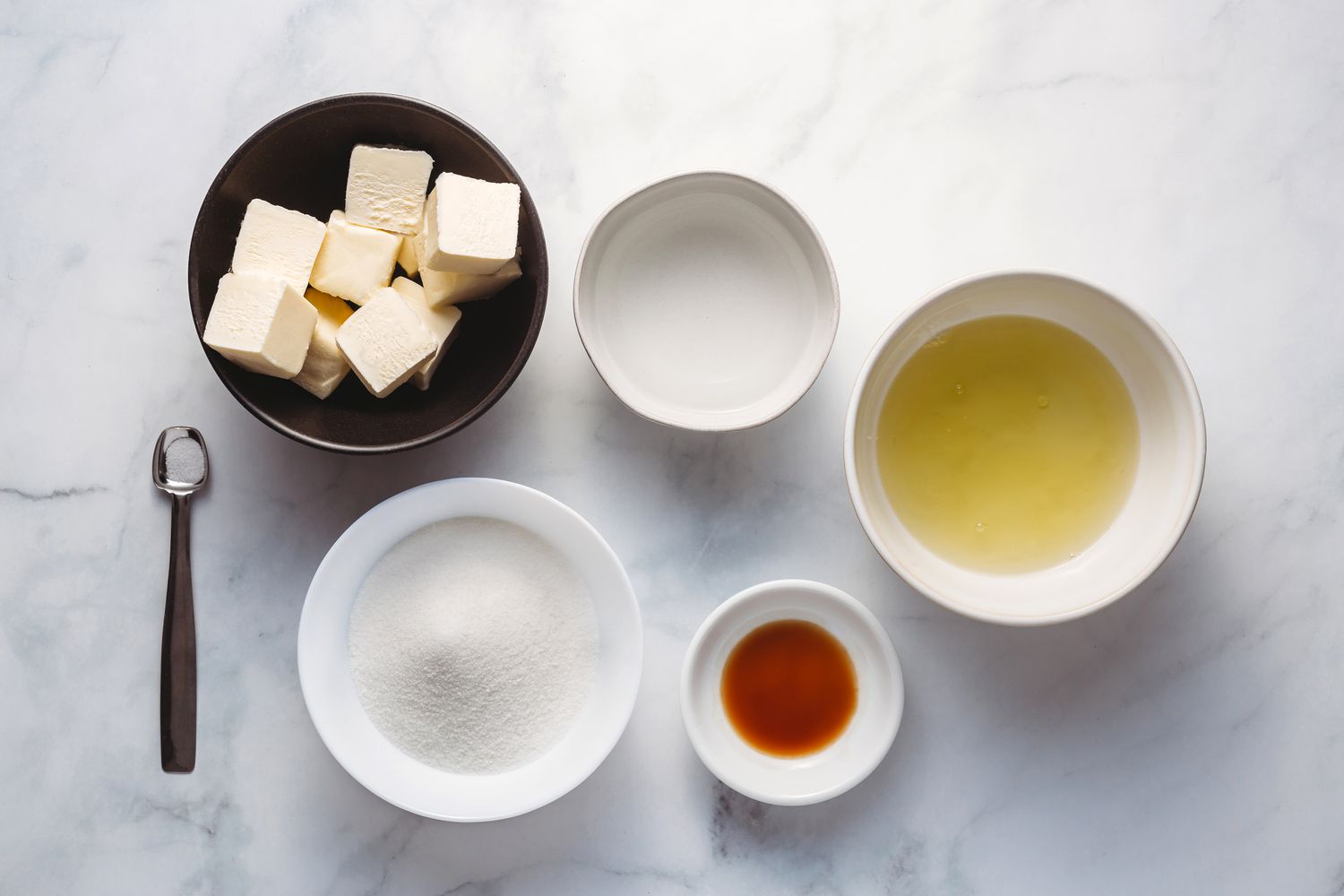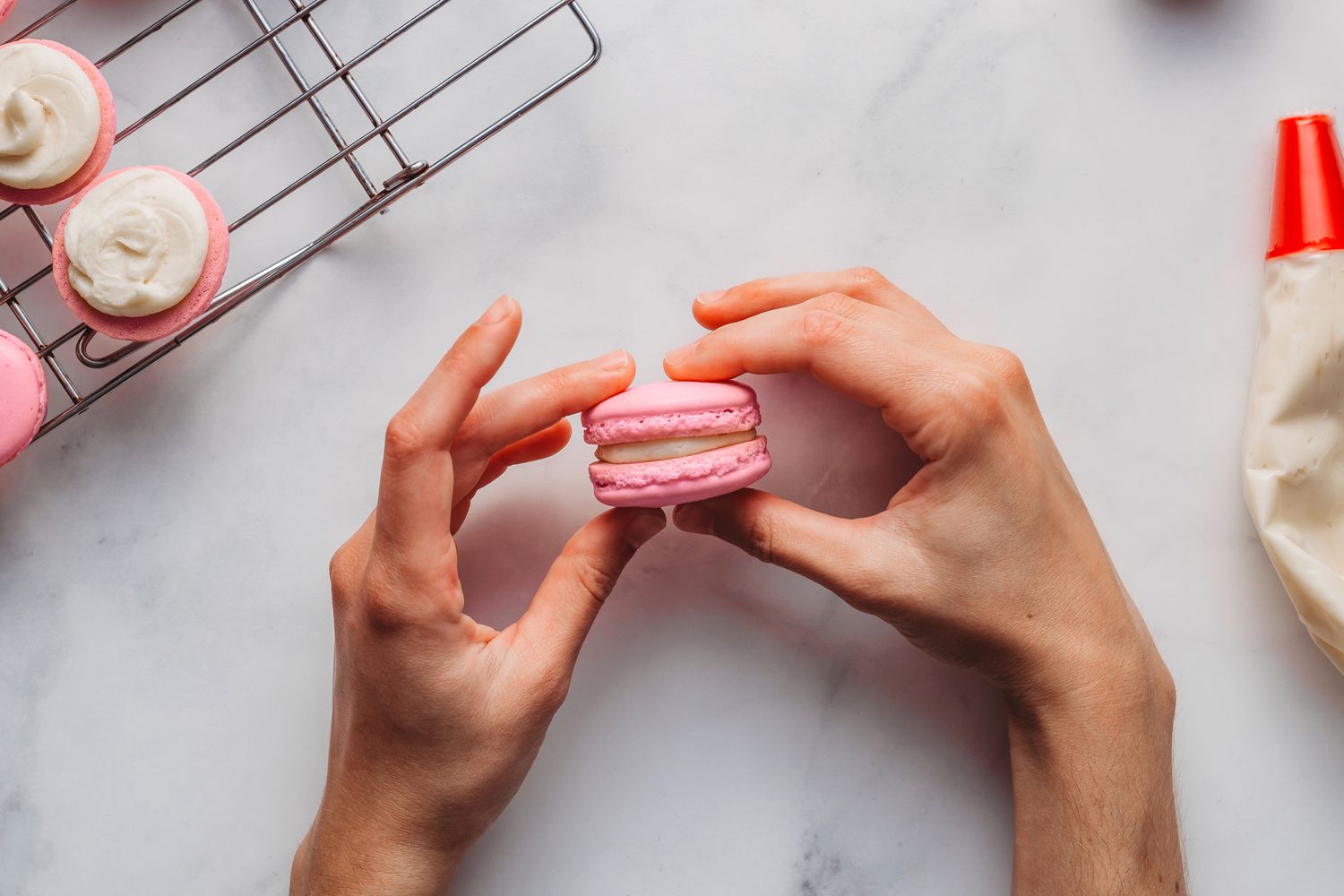Macarons are iconic. They've made their way from French pâtisseries to thousands of American bakeries. You can even find them at Starbucks and in the freezer section at Trader Joe's. Their recognizable shape and bright colors give them an irresistible quality, like edible jewels. But for all their ubiquity they can be tricky to make, especially for the home baker.
This recipe will guide you step-by-step to making beautiful macarons. And if you don't have success the first time, go easy on yourself! This is one of those confections that can take some practice to get just right.
The History of the Macaron
Some sources trace the macaron back to the Renaissance period when Queen Catherine de Medici brought her Italian pastry chefs—along with the treat—to France. However, the real story is quite a bit more complicated. Almond-based meringue cookies likely did originate in Venice in the eighth century, but their path to France is unknown.
Macarons began to appear in French cookbooks in the 17th century. However, these cookies were unfilled, unlike the macarons we know today. The filled version is the invention of the Ladurée family, owners of the well-known Parisian pastry shop and tea house, and came about on the early 1900s.
What’s the Difference Between Macarons and Macaroons?
The names are similar and easily confused for one another, but macarons and macaroons are distinctly different cookies. Both use a meringue of beaten egg whites and traditionally do not include wheat flour (some macaroon recipes do), so they’re gluten free.
Unlike American macaroons, French macarons are made by sandwiching two crunchy-on-the-outside and chewy-on-the-inside meringue cookies with a filling like chocolate ganache, buttercream, or jam. By contrast, American macaroons are drop cookies made with shredded coconut, baked to a golden brown, and are far easier to make.
The Spruce Eats / Abbey Littlejohn
How Do You Make Macarons?
Macarons start by preparing a meringue of egg whites and sugar, and folding in a sifted mixture of blanched almond flour and confectioners’ sugar. The batter is piped and baked, then filled with your desired filling. While that sounds simple, the devil is in the details!
What is Macaronage and How Do I Do It?
Perhaps the most mystery-shrouded part of the macaron making process is called the macaronage. The macaronage is when the almond flour mixture gets folded into the meringue. In most recipes made with whipped egg whites, the goal is to fold ingredients into the meringue as quickly and lightly as possible to avoid deflating the egg whites. Not so with macarons.
During the macaronage, when you first fold in the almond flour mixture the resulting batter will be thick and form a clump in the mixing bowl. Keep making the folding motion. As you fold, the batter will become looser. Eventually it will be glossy, smooth, and should have a lava-like consistency. At this point, when you stir, your spatula will make a track through the batter but that track will gradually disappear. If you allow the macaron batter to fall off the spatula back into the bowl, it will gradually be reabsorbed, leaving no trace.
When your batter meets these criteria it is ready for piping. Because this step is so counterintuitive to would-be macaron bakers, this is often where they go wrong. The tendency is to stop too soon, when the batter is thick. However, not mixing enough results in stodgy, rumpled-looking macarons. Mixing too much results in flat macarons.
What are Macaron “Feet?”
The small, fluffy ruffles on a macaron shell are called "feet." It's a trademark feature of well-made macarons.
If you're having trouble achieving the coveted feet during baking, this can be for a few reasons:
- The batter was too wet
- The humidity was too high
- The piped batter wasn’t allowed to sit long enough to let the skin develop
- The baking temperature was too low (an oven thermometer can help with accuracy)
Use an Italian Meringue for the Best Macarons
Our method uses an Italian meringue as the base for making the macarons. With an Italian meringue, a hot sugar syrup is slowly whipped into beaten egg whites, effectively cooking them. This results in a very stable meringue, which is beneficial for making macarons as the meringue can stand for longer before using and it gives you more leeway during the macaronage, helping you avoid over-mixing.
7 Common Mistakes to Avoid When Making Meringue
Macarons are Better the Second Day

The Spruce Eats / Abbey Littlejohn
Tips for Macaron Ingredients
- Store almond flour in the freezer to keep it fresh for longer. Old almond flour will make oily-looking macarons.
- Be mindful to use blanched almond flour, NOT almond meal. Almond meal has a coarser texture and often contains almond skins, which will yield thick, lumpy, speckled cookies.
- Use day old, room temperature egg whites. This increases the elasticity of the whites and creates a better meringue.
Tips for Making the Macaron Batter
- When making the Italian meringue, it is easier to whip the egg whites to medium peaks before starting to heat the sugar syrup. The egg whites can sit for a few minutes while the syrup comes to temperature. Proceeding this way means you're less likely to over-whip the egg whites or overshoot the temperature with the sugar syrup.
- When folding the meringue into the almond flour mixture, the mixture will look thick at first. Keep folding until it is glossy and has a lava-like consistency. When you allow batter to fall off the spatula back into the bowl, it should gradually be reabsorbed, leaving no trace.
- Place the piping bag with tip inside a large cup or pitcher, folding the edges of the bag around the opening of the vessel to help hold it open and still while you fill.
Tips for the Buttercream Filling
- For the best Italian meringue buttercream, make sure the butter and whipped egg whites are at the same temperature before starting to add the butter. If the two components are at different temperatures, the buttercream will break.
- If your buttercream breaks, it is either too warm or too cold. A soupy buttercream is too warm. A thick and lumpy buttercream is too cold.
- To fix a soupy buttercream, place the mixing bowl and beater in the fridge for 20 minutes. Beat for a few minutes. If the buttercream isn't quite coming together yet, place the bowl back in the freezer for 10 minutes at a time, beating after each, until it comes together.
- To fix a thick, lumpy buttercream, place the mixing bowl in a hot water bath until you can see the edges start to melt. Reattach the bowl to the stand mixer and beat for several minutes. If it is still lumpy, repeat this process as needed.
“French macarons are one of my absolute favorite treats. Once I had my first bite, I knew I had to learn how to make them. This recipe is a great starting point to help you master these tricky but delicious cookies. Feel free to change the flavors and colors to put your own spin on these.” —Tracy Wilk
 A Note From Our Recipe Tester
A Note From Our Recipe Tester
Ingredients
For the Macarons:
-
2 cups (192 grams) blanched almond flour
-
2 cups (227 grams) confectioners' sugar
-
1/4 teaspoon fine salt
-
7 medium egg whites, room temperature and preferably a day old, divided
-
1 cup (198 grams) granulated sugar
-
2/3 cup water
-
Food coloring paste (white or your choice)
For the Italian Buttercream Filling:
-
1 3/4 cups (347 grams) granulated sugar, divided
-
1 cup water
-
5 medium egg whites
-
1/4 teaspoon fine salt
-
1 pound unsalted butter, room temperature and cubed
-
1 vanilla bean, split and seeds scraped out (or 2 teaspoons vanilla extract)
Steps to Make It
Make the Macarons
-
Gather the ingredients.

The Spruce Eats / Abbey Littlejohn
-
In a large bowl, sift together the almond flour, confectioners' sugar, and salt. Whisk to combine.

The Spruce Eats / Abbey Littlejohn
-
Make a well in the center of the almond flour mixture and pour in 3 egg whites. Using a rubber spatula, fold and stir to make a paste. Set aside.

The Spruce Eats / Abbey Littlejohn
-
Place the granulated sugar and water in a small pot and stir to combine. Wet your fingertips or a pastry brush and wash down any sugar crystals on the side of the pot.

The Spruce Eats / Abbey Littlejohn
-
Heat on medium-high heat without stirring until the mixture reaches 238 F on a candy thermometer.

The Spruce Eats / Abbey Littlejohn
-
While you are waiting for the syrup to reach temperature, place the remaining 4 egg whites in the bowl of a stand mixer fitted with the whisk attachment. Whisk on medium-high speed until they reaches medium peaks. Turn off the mixer and wait for the sugar syrup to reach temperature.

The Spruce Eats / Abbey Littlejohn
-
Once the sugar syrup has reached 238 F, turn the mixer back on medium speed to bring the egg whites back together and slowly drizzle the syrup down the side of the mixer bowl in a thin, steady stream until fully incorporated in the egg whites.

The Spruce Eats / Abbey Littlejohn
-
Turn the mixer on medium-high and continue beating until the egg whites are inflated, smooth, shiny, flexible, and still a little warm, about 1 minute.

The Spruce Eats / Abbey Littlejohn
-
If using food coloring, squeeze a few drops to reach your desired color into the meringue and whisk for another 5 seconds or until completely incorporated.

The Spruce Eats / Abbey Littlejohn
-
Take a small amount of the meringue and fold it into the almond flour mixture to lighten it up.

The Spruce Eats / Abbey Littlejohn
-
Fold about half of the remaining meringue into the almond mixture using broad strokes until few streaks are left.

The Spruce Eats / Abbey Littlejohn
-
Fold the rest of the meringue into the batter until no streaks are left.

The Spruce Eats / Abbey Littlejohn
-
Continue to fold the mixture until the batter slowly drips off the spatula like lava and slowly settles flat, not leaving any peaks.

The Spruce Eats / Abbey Littlejohn
-
Prepare a piping bag with a 1/3-inch circle piping tip and pour some of the macaron batter into the bag.

The Spruce Eats / Abbey Littlejohn
-
Pipe 4 small dots of batter directly onto each corner of a 12 x 17-inch sheet tray, then place a piece of parchment on top. This will prevent the paper from lifting up in the oven.

The Spruce Eats / Abbey Littlejohn
-
Hold the piping bag vertically (perpendicular to the work surface) about a half-inch from the parchment and gently squeeze to pipe a 1 1/2-inch circle without moving the piping bag. Repeat, making sure to leave space in between each macaron, until all the batter is gone.

The Spruce Eats / Abbey Littlejohn
-
Gently tap the tray on the counter to remove any air bubbles. Let sit for about 30 minutes until the surface of the macaron is dry to the touch. Preheat the oven to 300 F.

The Spruce Eats / Abbey Littlejohn
-
Bake the macarons for 15 to 20 minutes, rotating halfway through, until the shell is hard and the center is still chewy. Let cool completely.

The Spruce Eats / Abbey Littlejohn
Make the Filling
-
Gather the ingredients.

The Spruce Eats / Abbey Littlejohn
-
In a small pot, add 1 1/2 cups (297 grams) sugar and the water and stir to combine. Wet your fingers or a pastry brush and wash off any sugar crystals off the sides of the pot.

The Spruce Eats / Abbey Littlejohn
-
Place over medium-high heat until the sugar syrup reaches 238 F. Do not stir the syrup while it is cooking—this will cause the sugar to crystallize.

The Spruce Eats / Abbey Littlejohn
-
In the meantime, place the egg whites and salt into a stand mixer bowl fitted with the whisk attachment. Whisk on medium speed until the whites become frothy.

The Spruce Eats / Abbey Littlejohn
-
Slowly add the remaining 1/4 cup (50 grams) sugar until fully combined. Turn the speed up to high and continue to whisk until medium-stiff peaks. Turn off the mixer and wait for the sugar syrup to reach temperature.

The Spruce Eats / Abbey Littlejohn
-
When the sugar syrup reaches 238 F, remove the pot from the heat and turn the mixer back on low speed. Slowly pour the sugar syrup down the side of the mixing bowl in a thin, steady stream until fully incorporated.

The Spruce Eats / Abbey Littlejohn
-
Turn the speed to medium-high and continue to beat until it has doubled in size and the bowl is no longer warm to the touch. Ideally the meringue should be between 72 to 75 F. Make sure your butter is also within this temperature range.

The Spruce Eats / Abbey Littlejohn
-
Turn the speed back down to medium and slowly add the butter chunks until smooth and fluffy. Add only a couple butter cubes at a time and wait for them to be incorporated before adding the next. Adding the butter too quickly can cause the meringue to deflate.

The Spruce Eats / Abbey Littlejohn
-
Lower the speed and add the vanilla. Continue to mix until everything comes together into a beautiful silky smooth buttercream.

The Spruce Eats / Abbey Littlejohn
Assemble the Macarons
-
Prepare a piping bag with 1/4-inch circle piping tip.

The Spruce Eats / Abbey Littlejohn
-
Fill the piping bag with the buttercream.

The Spruce Eats / Abbey Littlejohn
-
Flip half of the macaron shells upside down and pipe a circle of buttercream onto each shell.

The Spruce Eats / Abbey Littlejohn
-
Place the other half of the macaron shells on top of the buttercream. Make sure to pair similar-sized discs together for more consistent macarons.

The Spruce Eats / Abbey Littlejohn
-
The macarons can be served immediately, but many say they are actually better after freezing overnight.

The Spruce Eats / Abbey Littlejohn
Troubleshooting Macarons
- Lopsided macarons: The macarons rested too long, the oven heat was uneven, or they were improperly piped.
- Cracked macarons: There was too much air in the batter. Overbeating and not letting the shells dry well enough before baking are two factors that may cause a hollow, cracked shell. Additionally, pay close attention to the batter texture during the macaronage stage. It takes some practice to know when it's perfect.
- Hollow shells: Either under whipping or over whipping the egg whites, under baking, or improper folding of the batter.
- Flat shells: This is usually due to overmixing the batter.
- Wrinkly or blotchy shells: Oily/old almond flour, over-beaten meringue, or overmixed batter can cause this issue.
- Buttercream looks like soup: Either the meringue was too warm before adding in the butter or you just need to whip it longer. If whipping it longer is not working, try putting the whole bowl in the fridge for 20 minutes to chill, then scrape down the sides and whip again.
- Buttercream is chunky: The ingredients were too cold. Let it come to room temp or place the mixing bowl in a hot water bath for a few minutes and try whipping again.
How to Store and Freeze
Macarons can be stored in an airtight container in the fridge for three days or in the freezer for up to three months.
Recipe Variations
- Vary the fillings by using ganache, jam, or pastry cream instead of buttercream. Or pipe a buttercream "dam" around the edge of the macaron and fill it with jam or citrus curd.
- Fill the macaron shells with small scoops of ice cream.
Buttercream can be flavored in a variety of ways.
- Add powdered freeze dried fruit for fruity buttercreams.
- Beat in 4 ounces melted and cooled bittersweet or semisweet chocolate plus 2 tablespoons sifted cocoa powder after beating in the butter.
- Beat in 2 tablespoons sifted matcha after beating in the butter.
- Beat in the zest of 2 lemons or limes and a pinch of citric acid (if you have it–this just adds a nice tart zing without added liquid) after beating in the butter.
- Beat 1 tablespoon instant coffee or espresso powder with the egg whites.
- Grind 1 tablespoon Earl Grey tea into a fine powder and beat it in after beating in the butter.
The macaron shells can be flavored as well, however this usually requires some modifications to the base recipe. Try to find recipes specifically for the flavor of macaron shell you want to make.


